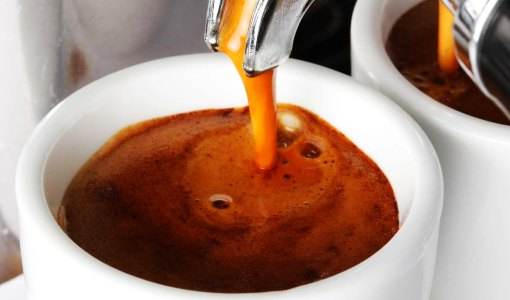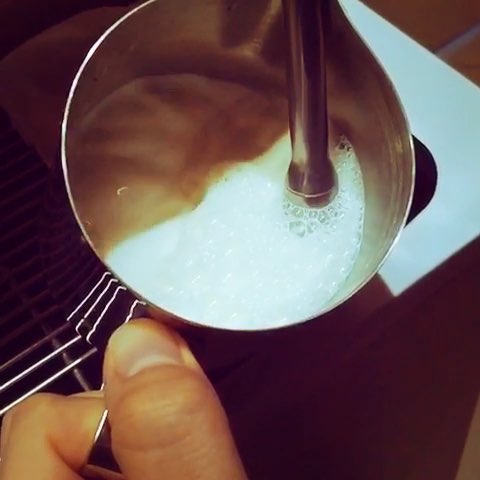Production method of Italian espresso
Follow the caf é (Wechat official account vdailycom) and found that Beautiful Cafe opened a small shop of its own.
① extraction principle
Espresso (Italian espresso, also known as espresso) is essentially a filtration method that uses a precision metal filter. Compared with gravity filtration, the biggest difference is pressure. The espresso machine pushes high-pressure water through the coffee pressed powder, that is, even though the coffee powder itself is extremely fine, it still ensures moderate percolation and balanced extraction. What does that mean? The smaller the coffee powder is, the more its surface area increases exponentially, so one of the advantages of ultra-fine powder is that the extraction speed is very fast. Not only faster, but also of better quality. High pressure can squeeze water into the inner cell wall of coffee powder, and the effects of extracting emulsified oil and dissolving sugars cannot be done by gravity alone. Espresso symbolizes complex and condensed coffee, and no other brewing method can show such mellow thickness and texture.
Excellent extraction is the only way to brew coffee, and espresso is no exception. It doesn't sound difficult, but the intensity of the espresso brewing process is the problem we have to face. Extracting the best part of the coffee in a very short interval is no less difficult than rinsing yourself with a fire hose in 30 seconds. In the case of espresso, good extraction refers to a balance between a large number of aromatic compounds and taste compounds. In other words, the bitterness should be structural, the acidity should be fresh, and the sweetness should be long-lasting-of course, no matter which method of cooking, these are the goals we pursue. All coffee is flawed in one way or another, and you can't improve the quality by tasting it and know when it's best to drink it, but according to the absolute minimum
By observing the extraction rate, you can clearly know when this espresso is the worst. Double espresso usually has 30 to 45 grams, and it takes 25 to 35 seconds to get a full picture, depending on the characteristics of the coffee itself. In the case of lightly roasted Kenyan coffee (I mean general coffee beans), in order to suppress its acidity, a low flow rate and a long extraction process (at least 30 seconds) is necessary; if it is a deeply roasted Brazilian coffee, in order to control its bitterness, it may be more suitable for violent brewing.
As a rule of thumb, acids are first extracted, so espresso that is underextracted (flows too fast) tastes sour. Then there is sweetness, but the actual sugar content of roasted coffee is so low that it is difficult to set a standard. Sweetness is also a physiological feeling, but it is related to aroma components and strong texture, so it also symbolizes excellent mellow thickness. Bitterness is usually extracted in the final stage, and these slowly dissolved compounds balance the finished product in the cup from a global point of view; but if extracted too much, bitterness can easily drive away other flavors.
What about the aroma? The aroma quality of espresso is the most different from each other, so it is almost impossible to make coffee according to a particular aroma curve. The aroma of the coffee in the cup is determined by the grower and the roaster, which does not reflect the skill of the barista, but the latter can change the way we perceive the aroma by adjusting the taste curve. Baristas can adjust the acidity of the coffee, such as highlighting the sour taste of oranges or the aroma of grapefruit. The same coffee, if pulled more tightly, tastes more bitter and sweet, with a taste of orange chocolate or grapefruit jam.
② water temperature
All kinds of cooking methods are affected by the water temperature. If you are a novice, since you already have a lot of factors to deal with, there is no need to care too much about the brewing temperature of espresso. Moreover, the brewing ratio, the depth of coffee roasting, coffee variety and processing process can have an impact on the optimal brewing temperature. Not all espresso machines have the function of adjusting the temperature of the brewing head, but generally speaking, the deeper the baking, the lower the cooking temperature (90 ~ 92 ℃), and the lighter the roasting.
Should be higher (93 ~ 95 ℃).
③ quantification and distribution
Put a dose of coffee powder ranging from 14 to 22 grams in a clean filter handle powder bowl. The specific amount of use depends on the capacity (different size) of the powder bowl and the amount and concentration of coffee you want to make. If there is too much loading, the filter handle cannot be fixed to the cooking head. Of course, it can not be loaded less, otherwise the top space of coffee powder will be too large, which will not only lead to cake-shaped coffee paste, but also make the flow velocity unstable. At least at the beginning, remember to weigh the amount of coffee each time, so as to calculate the proportion of coffee when making a cup of coffee. Also, coffee powder may need more or more at this time.
Less redistribution, but first of all depends on how different types of grinders produce powder.

③ pressing powder
Next, flatten the coffee powder with a flat head press. The very fine powder directly received from the grinder is usually somewhat "fluffy". After flattening, it can not only drain the air in the gap, but also form a compact and flat cake to ensure uniform extraction as the water flows through. If the coffee cake is uneven, the water will flow to the place with the least resistance. At the end of the brewing stage, some coffee cakes with large water flow are overextracted, otherwise the extraction is insufficient. Compacting the coffee powder hard enough to drain the air from the crevice is the second goal. The deep or shallow pressure has no effect on the extraction rate, because the impact pressure of the Italian coffee machine on the coffee cake is 9 bar.
(58.5 kg / square inch), which is much stronger than the strength of human arms.
In recent years, people seem to attach too much importance to the powder pressing operation of espresso, and even inexplicably develop a sense of reverence. I think the mysterious halo around the powder comes from the powerlessness of brewing espresso: the process is hidden in the machine most of the time, so it's easy to exaggerate this WYSIWYG, even some affectation.
④ prepreg
Before inserting the filter handle, it is usually necessary to let the boiling head flow a little water. This is to ensure that the boiling water pumped from the boiler is fresh enough and the constant temperature effect is better. Then insert the filter handle into the cooking head, lock, and clamp the edge of the powder bowl with a rubber pad-the necessary pressure for the extraction process is maintained by this gasket. As the coffee has left the lotus head strainer and rinse
The high temperature components in the cooking head are quite close, and from now on, the faster the prepreg and extraction, the better. Recognize your coffee machine, or press the button, or pull the lever, or push the control oar, the fun begins!
The first contact between water and coffee is called "pre-soaking", which means wetting the coffee powder with a small amount of water. Some machines use current limiting valves (or prepreg chambers of new machines) for automatic prepreg operation, while others are mainly controlled manually. The prepreg stage is usually only 3-10 seconds, but it is very important. The extraction process starts with a high-speed stamping, and the prepreg is like a warm-up before that, while smoothing the uneven density of coffee cakes in the powder bowl. After absorbing the first wave of water, the coffee cake begins to expand, squeezing out the air in the small space. Adjusting the time and pressure of pre-soaking is a very difficult skill to master, but it can greatly improve the control over the extraction process of espresso.
Generally speaking, the longer the prepreg is, the faster the subsequent extraction process is. For example, an 18g (2amp 3oz) fine coffee powder and the same 18g coarse coffee powder extract the same weight of liquid. The extraction time of the former is the same as that of the latter without pre-extraction. This rule is also applicable to extreme cases such as ultra-fine coffee powder and ultra-long prepreg time (more than 10 seconds). At present, it is not fully explained why such a significant difference can be caused by a long period of prepreg. Some say it's because the fine coffee powder is trapped in the wet pressed powder (the pie-shaped coffee crumbs left with each espresso made). But according to my guess, the wet powder bowl turns the fine powder into freely flowing and mobile particles. Even if the pressure in the initial stage of extraction is relatively insufficient, they can move freely in a manner similar to capillaries. By the time the extraction officially begins, the fine powder has entered the standby state, and all the roadblocks have been cleared, so the extraction speed is of course relatively faster.
Even to the absolute limit, it is thought that the steaming of the wet pressed powder and subsequent extraction: a pressure up to 9 bar (58.5kg / square inch) is suddenly hit on the fine powder, and the upper layer of coffee powder falls to the bottom of the coffee cake like a sandbag, thus restricting water flow for the rest of the extraction stage. If the pressure is reduced by 1 ~ 2 bar (6.53 ~ 13 kg / square inch), the effect of steaming is milder and the flow of fine powder will not be so fierce.
⑤ extraction
The next step is moderate extraction, the system is fully pressurized, and the brewed coffee flows out of the nozzle of the filter handle. You will see a unique crimson coffee concentrate fall into the cup, and for many people who see this magical moment for the first time, the feeling will never be fully replicated.
Depending on the coffee, the time to extract the best flavor is usually between 25 and 35 seconds. At the same time, we can make an espresso with a minimum brewing ratio of 1 ∶ 1 (the weight ratio of finished coffee to coffee powder) and a maximum of 3 ∶ 1. My personal favorite brewing ratio is 1.5 ∶ 1, which translates to an easy-to-operate figure of 18 grams of coffee to make 27 grams of espresso. Deep-roasted coffee requires a relatively low brewing ratio, so the alcohol thickness is not as thick as light-roasted coffee-but low brewing ratio is more likely to retain the original appearance of the coffee.
It is important to keep in mind that the brewing ratio can only measure the concentration of coffee drinks, and the weight of coffee itself will also slow down or speed up the extraction process. In order to achieve the extraction equilibrium as we understand, the extraction rate of espresso under any production conditions should reach 18% ~ 22% (that is, the ratio of coffee dissolved into the cup to the original weight of coffee powder). If espresso spills over too quickly, underextracted coffee will have a sour taste; conversely, coffee will taste bitter and astringent.
A good barista can grasp the relevant information from the flow rate and shape of the nozzle of the fuselage, and then judge the freshness of the coffee, the amount of extraction and the extraction efficiency. Some kind of yellowish liquid appears in the middle of the extraction process, which is called "yellowing"; in the view of many people, this stage is of little help to the flavor of the rest of the extraction process. The final stage can also extract a lot of beautiful and even important tastes, so we should not be too obsessed with the gelatinous red droplets unique to the early stages-even though they are intoxicating.
When the water begins to twist or vaguely hang on the nozzle of the filter handle, it indicates that the surface tension of the liquid is increasing. This will only happen when the solubility of the extraction drops to a certain extent, that is, the extraction process is coming to an end. If the coffee is coarse and thin from the beginning, your coffee will probably be underextracted. However, visual judgment can only give a general hint of the flavor of the coffee, and only by taking a sip can you know whether the coffee you make is good or not.
If the coffee machine thinks that the extraction is over, the extraction operation is over. Some machines automatically determine when to turn off by measuring the amount of water pumped into the head. The latest generation of espresso machines sell with built-in scales, and baristas can accurately calculate the instant extraction rate after obtaining the weight data of espresso. Many baristas still advocate manual operation, believing that each espresso has its own unique temper and needs to be carefully taken care of according to different levels of feedback. I personally advocate programmable buttons, which respond reliably and can be tailored to everyone's needs in terms of coffee, dosage, grinding, and so on.
⑥ pressure
Few people care about stress when making espresso. Most machines can be set to a standard pressure of 9 bar (58.5 kg / square inch), and then you can let it go. Some modern Italian coffee machines have the function of directly regulating pressure in the process of brewing.
The process of making espresso already has a long list of troubles to consider, which for many people is tantamount to adding another parameter to the list. But if it doesn't hurt you to drink a few more cups of coffee, you might as well fiddle with the pressure curve and fine-tune the precision of the extraction process to open up a delicious new world for your cup of coffee. The water pressure on the coffee cake determines the contact time between the water and the coffee in the powder bowl. Extremely low pressure can make the contact time longer, otherwise it becomes shorter, and the specific contact time also depends on the coffee dose and grinding conditions.
The function of increasing or reducing pressure at the end of espresso brewing undoubtedly makes the barista feel like a tiger. In the final analysis, all of these operations depend on what kind of espresso you want. Large beverages made of coarse coffee powder with low pressure and small cups made of fine coffee powder with high pressure have the same degree of balance and taste good. But they are two completely different drinks, depending on your choice.
Important Notice :
前街咖啡 FrontStreet Coffee has moved to new addredd:
FrontStreet Coffee Address: 315,Donghua East Road,GuangZhou
Tel:020 38364473
- Prev

How to make milk foam in a coffee machine
The high content of fat makes the milk look silky, smooth and dense, with an obvious taste and a more mellow taste. But that's what happens in the world, and the best food is always accused of being bad for your health. For those who are worried about fat content, they can buy skim or semi-skim milk. In order not to compromise on quality, I would rather touch the editor.
- Next

Starbucks cappuccino approach
Following Cafe (official Wechat account vdailycom) found that cappuccino has an irresistible unique charm. At first it smells delicious, the first sip, you can feel the sweetness and softness of a large number of milk bubbles, the second taste can really taste the original bitterness and richness of coffee beans, and finally when the taste stays in the mouth.
Related
- Beginners will see the "Coffee pull flower" guide!
- What is the difference between ice blog purified milk and ordinary milk coffee?
- Why is the Philippines the largest producer of crops in Liberia?
- For coffee extraction, should the fine powder be retained?
- How does extracted espresso fill pressed powder? How much strength does it take to press the powder?
- How to make jasmine cold extract coffee? Is the jasmine + latte good?
- Will this little toy really make the coffee taste better? How does Lily Drip affect coffee extraction?
- Will the action of slapping the filter cup also affect coffee extraction?
- What's the difference between powder-to-water ratio and powder-to-liquid ratio?
- What is the Ethiopian local species? What does it have to do with Heirloom native species?

